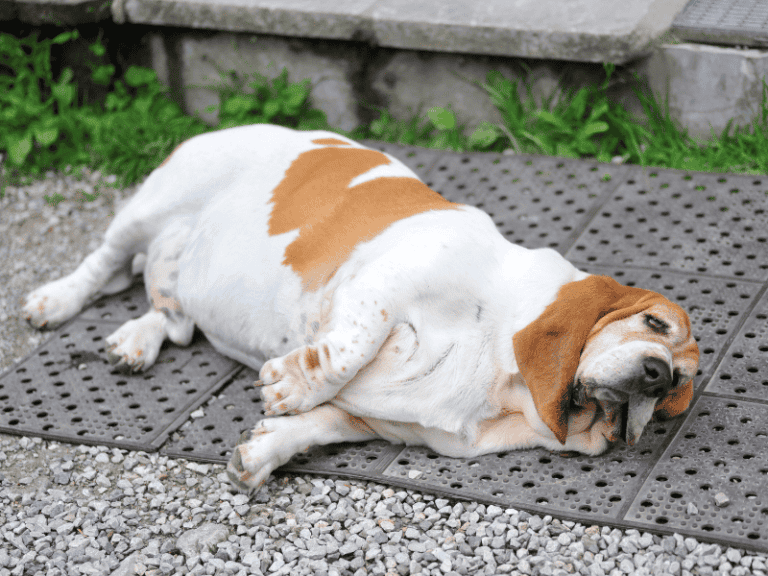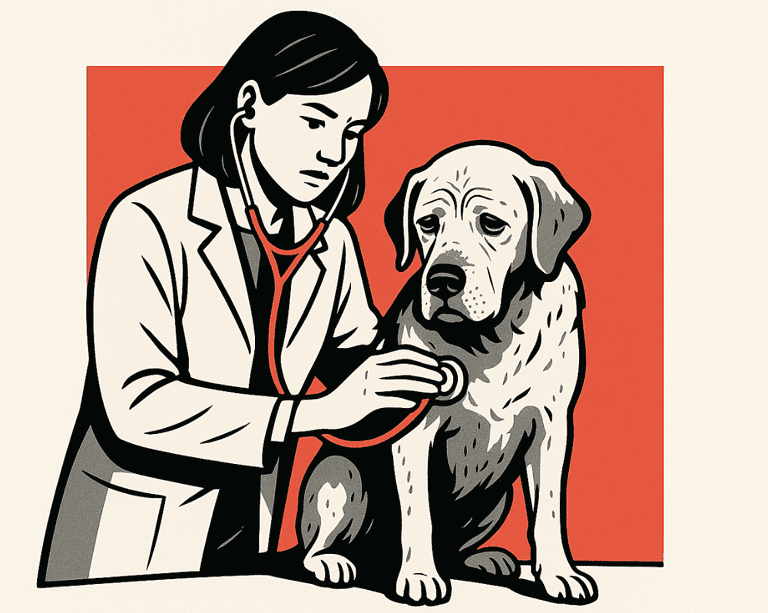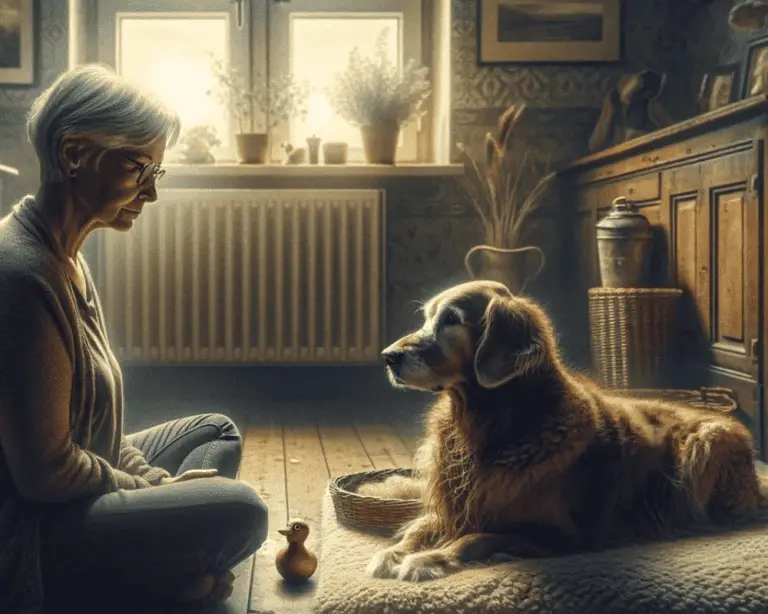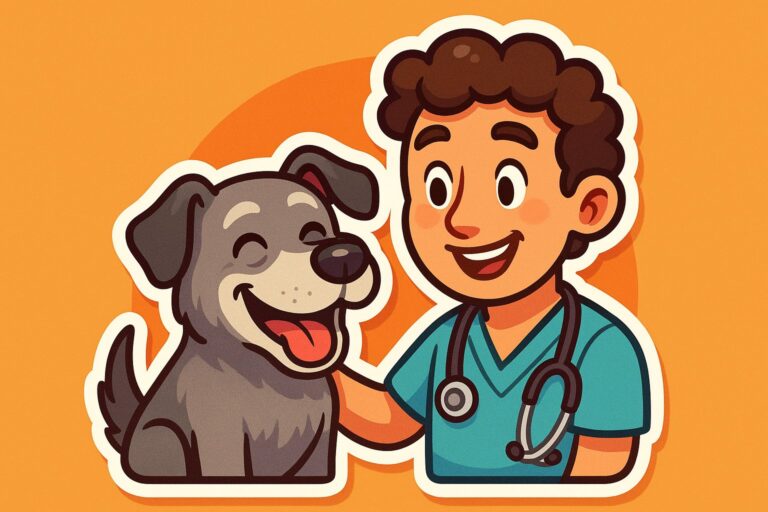10 Warning Signs Your Senior Dog Is in Pain
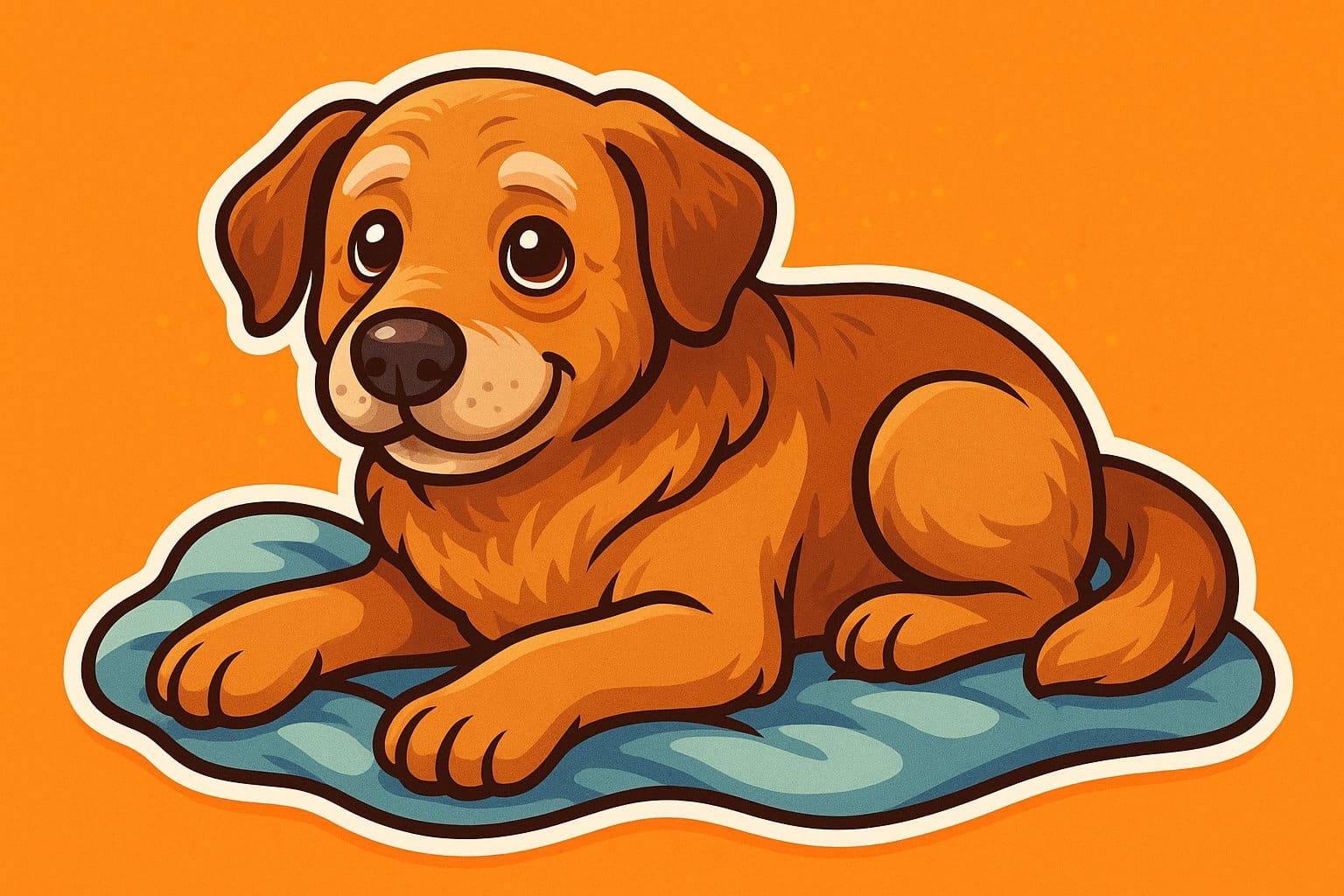
Dogs age much faster than we do. By the time your furry friend turns seven, they’re already considered a senior.
Just like people, older dogs can develop aches and pains. But here’s the tricky part: they’re incredibly good at hiding when something hurts.
Maybe you’ve noticed your dog moving a little slower lately. Perhaps they’re not as eager to jump on the couch for evening cuddles.
These small changes might seem like normal aging. But they could actually be your dog’s way of telling you they’re uncomfortable.
1) Limping or Favoring a Leg, Your Dog’s Way of Saying „That Hurts, and I’m Avoiding It.“
Have you noticed your senior dog walking differently lately? Maybe they’re not putting their full weight on one paw, or they’re taking shorter steps than usual.
Limping stands out as one of the clearest signs your older dog is dealing with pain. Just like you might favor a sore ankle, your dog will naturally protect a painful leg or paw.
You might see your dog holding one leg up slightly while standing. Or maybe they take careful, slower steps to avoid putting pressure on the sore spot.
Sometimes the limping is obvious. Your dog might hop on three legs or avoid using one paw completely.
Other times, it’s more subtle. Your dog might just seem a bit „off“ in their walk, or they may be slower getting up from their bed.
Watch how your dog moves when they first wake up. Senior dogs with joint pain often show the most stiffness after resting, just like people do.
If you notice any changes in how your dog walks or stands, take them to your vet. Pain doesn’t have to be part of getting older.
2) Reluctance to Climb Stairs or Jump, Like When Your Favorite Armchair Suddenly Feels Out of Reach
Have you noticed your dog staring at the stairs like they’re Mount Everest? This sudden hesitation to jump or climb often means your senior pup is hurting.
Maybe your dog used to leap onto your bed every morning for cuddles. Now they just sit beside it, looking up with those pleading eyes that say „help me up.“
Back pain is usually the culprit here. When your dog climbs stairs, it puts extra pressure on their spine and joints.
If it hurts, they’ll quickly learn to avoid it altogether. Arthritis in the hips or legs can make jumping feel impossible too.
Think about how you might avoid certain movements when your back aches. Watch how your dog moves around furniture they used to hop on easily.
Are they walking around the coffee table instead of jumping over it? If your dog can still go downstairs but won’t go up, that’s a big red flag.
Going down is easier on sore joints than pushing up against gravity. This change often happens gradually, so you might not notice right away.
But once you see it, it’s hard to miss.
3) Whining or Yelping During Movement, Especially When Getting Up or Lying Down
Have you noticed your senior dog making sounds when they stand up from their favorite napping spot? This vocal response often signals that something isn’t quite right.
When your older dog whines or yelps during movement, they’re telling you they’re uncomfortable. Think of it like your own groaning when you get out of bed on a stiff morning, except your dog can’t explain what hurts.
Joint pain and arthritis are common culprits behind these sounds. Your dog’s joints grow stiffer with age, making those first movements after rest particularly painful.
You might notice your dog hesitates before getting up or moves more slowly than usual. Maybe they whine when lying down too, as they try to find a comfortable position.
Pay attention to when these sounds happen most. Is it worse in the morning or after long naps?
Cold weather can make joint stiffness even more pronounced. If your dog only makes noise during these transitions but walks normally afterward, joint issues are likely the cause.
However, don’t wait to see if it gets worse, early intervention can help keep your furry friend more comfortable.
4) Changes in Appetite or Difficulty Chewing, Possibly Because of Mouth or Tooth Pain
Have you noticed your senior dog suddenly becoming picky about their favorite kibble? This could be their way of telling you their mouth hurts.
Dental problems are extremely common in older dogs. Your dog might be dealing with inflamed gums, loose teeth, or painful tooth decay that makes every bite uncomfortable.
Watch how your dog approaches their food bowl. Do they seem interested but then walk away after a few bites?
Maybe they’re dropping food frequently or chewing only on one side of their mouth. Some dogs will try to swallow their food whole to avoid chewing.
Others might prefer softer foods over their usual crunchy treats. If your dog used to gulp down meals and now eats slowly or hesitantly, their mouth is probably causing pain.
You might also notice bad breath or see them pawing at their face. Don’t assume appetite changes are just part of aging.
Your vet can examine your dog’s mouth and recommend treatment options like dental cleaning or pain management to help them enjoy their meals again.
5) Excessive Licking or Biting a Specific Spot, Often a Hidden Sore or Irritation
Have you noticed your senior dog constantly licking the same spot on their leg or paw? This repetitive behavior often signals pain or discomfort that you might not immediately see.
Older dogs frequently develop arthritis, skin irritations, or small wounds that bother them. When they can’t tell you something hurts, they lick or bite the area instead.
If your dog keeps returning to lick one specific spot, take a closer look. You might find a small cut, irritated skin, or swelling that needs attention.
This constant licking can actually make things worse. The moisture and bacteria from their mouth can turn a minor irritation into a bigger problem called a lick granuloma.
Watch for red, swollen, or hairless patches where your dog has been licking. These areas often feel warm to the touch and may have an unusual smell.
Should you notice your senior dog obsessively licking any particular spot for more than a day, it’s time to call your vet.
6) Noticeable Stiffness or Slower Movements, Especially After Naps, Think of It as Their Morning Creakiness
Have you ever watched your senior dog struggle to get up after a long nap? Just like us humans who feel stiff after sleeping in an awkward position, older dogs often experience that same „creaky“ feeling when they first wake up.
You might notice your dog taking longer to stand up from their bed. They may stretch more than usual or walk with a shuffled gait for the first few minutes after waking.
This stiffness happens because their joints become less flexible with age. The muscles and joints literally „cool down“ during rest periods, making movement feel uncomfortable at first.
Pay attention to how long this stiffness lasts. A minute or two of morning creakiness is normal for senior dogs.
But if your dog seems stiff for extended periods or shows obvious discomfort, this could signal arthritis or joint pain. Watch for subtle changes in how your dog moves throughout the day.
Do they hesitate before jumping onto the couch? Are they slower on walks than they used to be?
Keep a mental note of your dog’s mobility patterns—it helps you spot when something’s not quite right.
7) Sudden Irritability or Snapping When Touched, Which Wasn’t Their Style Before
Has your once-gentle dog started snapping when you reach out to pet them? This sudden change in behavior often signals that your senior dog is dealing with pain.
When dogs hurt, they can’t tell us with words. Instead, they communicate through their actions.
A dog who used to love belly rubs might now growl when you touch their stomach. Pain makes dogs protective of their bodies.
They may snap or show their teeth when you try to touch areas that hurt. This isn’t mean behavior, it’s their way of saying „that hurts, please stop.“
You might notice your dog becomes grumpy during activities they used to enjoy. Brushing, nail trims, or even gentle petting can trigger irritable responses.
Pay attention to which areas seem most sensitive. Does your dog react when you touch their back, legs, or head?
These reactions can help your vet pinpoint where the pain might be coming from.
8) Unusual Panting or Heavy Breathing Even When Resting, a Sign That Pain Might Be Sneaking In
Have you noticed your senior dog breathing heavily while just lying on their favorite couch spot? This could be your dog’s way of telling you something isn’t quite right.
When dogs feel pain, their bodies work harder to cope. This extra effort often shows up as unusual panting or heavy breathing, even when they’re resting.
Think of it like when you have a bad headache. Your whole body feels tense and works harder than usual, even when you’re sitting still.
Your older dog might pant more because pain makes them feel stressed or uncomfortable. Their heart rate goes up, and they need more oxygen to deal with what they’re feeling.
If your dog suddenly starts breathing heavily during quiet moments, pay attention. Maybe they’re panting while watching TV with you or breathing hard after just walking to their food bowl.
This type of breathing looks different from normal post-exercise panting. You might notice deeper chest movements or hear louder breathing sounds than usual.
Should you see this happening regularly, it’s worth checking with your vet.
9) Avoiding Playtime or Walks They Used to Love, Like a Favorite Park Now Feeling Like a Trek
Does your senior dog suddenly turn away when you grab their leash? Maybe that tail that used to wag at the mention of „walkies“ now stays still.
This change often signals that your dog is experiencing pain or discomfort. Dogs are masters at hiding their pain, but avoiding activities they once loved is a clear red flag.
Your pup might be dealing with joint pain, arthritis, or dental problems that make movement uncomfortable. That favorite park route might now feel overwhelming when every step hurts.
You might notice your dog cowering or backing away during playtime invitations. They could also seem less interested in their favorite toys or games.
Pay attention if your dog starts choosing shorter routes during walks or stops more frequently. These subtle changes tell you something important about their comfort level.
If your once-playful companion now prefers staying on their bed, don’t assume it’s just laziness.
10) Changes in Posture or a Hunched Back That Suggests Discomfort in the Spine or Joints
Have you noticed your senior dog walking differently lately? A hunched back or changed posture is one of the clearest signs your dog might be dealing with pain.
Dogs with spine or joint discomfort often arch their backs upward, similar to how you might hunch over when your back hurts. This hunched position helps them protect painful areas and reduce pressure on sore spots.
You might see your dog standing with their head lower than usual or walking with a stiff, careful gait. Some dogs also keep their tails tucked under more often when their back bothers them.
Watch how your dog moves when they think you’re not looking. Dogs are masters at hiding pain from their owners, but they can’t always control their body language.
If your dog’s back looks rounded like a mountain instead of fairly straight, it’s worth a vet visit.
Why Older Dogs Hide Pain
Dogs naturally hide their discomfort, making it hard for you to spot when something’s wrong. Many pet parents also mistake pain signs for normal aging changes.
How Canine Instincts Play a Role
Your dog’s ancestors survived by hiding weakness from predators and pack members. This survival instinct runs deep in your pet’s DNA.
In the wild, showing pain meant becoming an easy target. Weak animals got left behind or attacked by rivals.
Your senior dog still carries these ancient instincts. They don’t really understand that your home is safe. Their brain tells them to act normal even when they hurt.
Dogs hide pain through:
- Continuing daily routines despite discomfort
- Avoiding obvious limping or whining
- Staying close to their pack (your family)
- Eating and drinking to appear healthy
Have you ever pushed through pain at work so others wouldn’t worry? Your dog does the same thing. They want to protect their place in your family pack.
This masking behavior explains why over 65% of pet parents miss early pain signs. Your dog works hard to seem fine.
Common Misconceptions About Aging and Pain
Maybe you’ve thought „he’s just getting old“ when your dog moves slower or sleeps more. This thinking can delay important medical care.
Pain vs. Normal Aging:
- Normal aging: Gradual slowing down, some stiffness after long rests
- Pain: Reluctance to move, avoiding stairs, changes in personality
Many pet parents believe senior dogs naturally become less active. While energy levels do drop with age, sudden behavior changes usually signal pain.
Your 10-year-old dog shouldn’t struggle to stand up every morning. That’s pain, not just age.
If your dog stops greeting you at the door or quits playing with their favorite toy, don’t assume it’s just personality changes. These shifts often mean they’re not feeling well.
Pain makes dogs withdraw from activities they once enjoyed. Your dog isn’t being lazy or stubborn.
Steps to Support Your Senior Dog’s Comfort
Making your older dog comfortable doesn’t require expensive treatments or major changes. Small adjustments at home and planning ahead for vet visits can make a huge difference in how your dog feels day to day.
How to Keep Vet Visits Stress-Free
Does your senior dog get anxious at the vet? You’re not alone. Lots of older dogs seem to find these visits more stressful as they age.
Before the appointment, ask if you can bring a favorite blanket or toy. That familiar smell might help your dog feel a bit safer in such an unfamiliar place.
If you have two dogs, try bringing both along. Sometimes, the buddy system just works wonders for nervous pets.
Book the first appointment of the day if you can. Your dog won’t have to wait as long, and there are usually fewer stressed animals in the waiting room.
Bring high-value treats your dog really loves. Even if they’re not usually food-motivated at the vet, something extra special could make a difference.
Ask your vet about anti-anxiety options if your dog gets extremely stressed. Some vets can prescribe mild sedatives for particularly anxious senior dogs.
Try to stay calm yourself. Your dog picks up on your energy, probably more than you realize.
Simple Adjustments at Home
Your home really shapes your senior dog’s daily comfort. Even a few tweaks can ease pain and help them move around more easily.
Temperature control becomes more important as dogs age. Try to keep rooms cozy, and maybe grab a sweater for your pup during chilly days.
Flooring changes can help prevent slips and falls. Toss down some non-slip rugs on smooth floors.
Yoga mats work well in spots where your dog walks a lot. If your dog struggles with mobility, grip socks might be worth a shot.
Sleeping arrangements deserve some thought. Orthopedic beds usually give better joint support than regular ones.
Food and water placement should be simple for your dog to reach. Raised bowls often help dogs with neck or back pain eat more comfortably.
Gentle exercise keeps joints moving but doesn’t overdo it. Short, frequent walks tend to work better than long hikes for most senior dogs.

